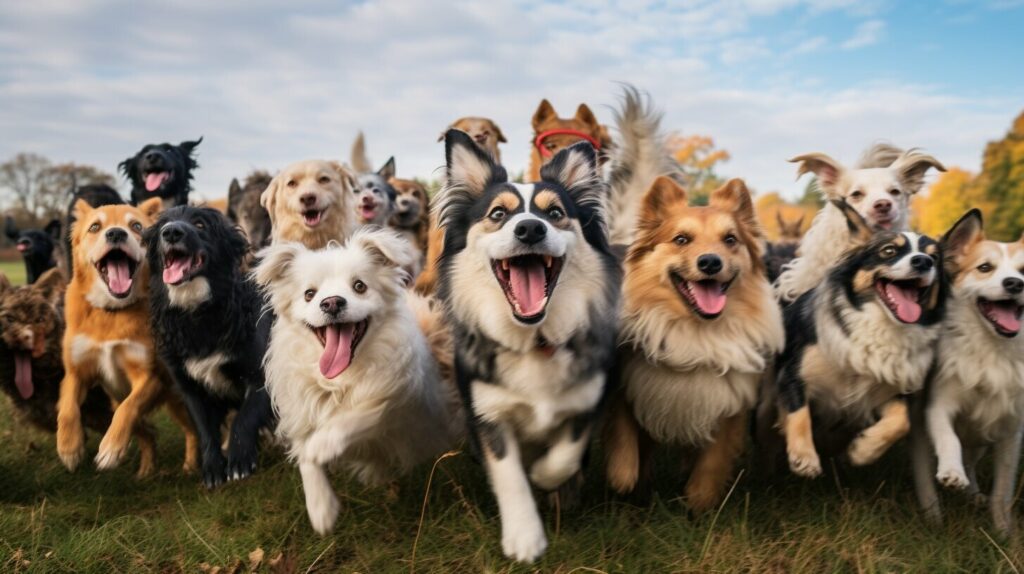Understanding your dog’s body language is an essential part of building a stronger bond with your pet. When you can interpret your dog’s non-verbal cues accurately, you can better understand their emotions and needs. Canine communication relies heavily on body language, and decoding dog expressions is vital to improving communication and developing a deeper connection with your furry friend.
Key Takeaways:
- Interpreting a dog’s body language is essential for a strong bond with your pet.
- Decoding dog expressions accurately helps you to better understand their emotions and needs.
- Body language plays a significant role in canine communication.
The Basics of Dog Body Language
Understanding canine communication is essential to building a strong bond with your furry friend. Dogs communicate primarily through body language, so interpreting their signals accurately is crucial. Here are some fundamental aspects of dog body language that you should know:
| Postures | Tail Movements | Ear Positions | Facial Expressions |
|---|---|---|---|
| Standing tall and erect usually indicates a confident or dominant dog, while a crouched low posture suggests submission or fear. | A wagging tail can indicate happiness or excitement, while a tucked tail suggests fear or anxiety. | Perked ears show attentiveness and can indicate alertness or curiosity. On the other hand, flattened ears are a sign of fear or submission. | A relaxed mouth and open expression typically indicate a happy or content dog, while a tight-lipped or wrinkled snout can indicate aggression. |
It’s important to observe the overall body language of your dog and not just focus on isolated signals. For example, a wagging tail may not always indicate happiness – a dog may still be anxious or fearful despite wagging its tail.
The Importance of Interpreting Canine Body Language
Learning to interpret your dog’s body language can help you understand their emotions and needs more accurately. This can lead to better communication and a stronger bond between you and your furry friend. Recognizing when your dog is uncomfortable or scared can also help you avoid situations that may lead to aggression or stress. Additionally, interpreting canine body language can also help you identify health issues, such as pain or discomfort.
- Observe your dog’s overall body language, including postures, tail movements, ear positions, and facial expressions.
- Recognize the context of your dog’s behavior, such as interactions with other dogs or humans.
- Learn the various signals dogs use to communicate their emotions and intentions, and use this knowledge to respond appropriately.
By paying attention to your dog’s body language and responding appropriately, you can build a deeper connection with your pet and create a more harmonious and fulfilling relationship.
Signs of Happiness and Contentment in Dogs
If you want to bond with your furry friend and ensure their emotional well-being, it is essential to decode their body language. Understanding your dog’s non-verbal cues, such as their facial expressions, tail movements, and postures, can help you recognize and respond to their emotions and needs.
When your dog is happy and content, they show several clear signs that they are enjoying their time with you. Let’s take a closer look at some of the non-verbal gestures that dogs use to convey their happiness.
Relaxed Body Posture
A relaxed body posture is one of the most unmistakable signs that your dog is happy and at ease. When your dog is content, they will have a loose, relaxed posture with their weight evenly distributed. Their muscles will be relaxed, and they will not be tense or rigid.
You might also notice that your dog’s ears are relaxed and floppy, and their mouth is slightly open, with their tongue lolling out to the side.
Wiggly Tail Wagging
One of the most well-known signs of a happy dog is a wagging tail. However, it’s essential to understand that not all tail wagging is the same. When a dog is happy, they will often wag their tail in a loose, wiggly motion, with their whole body moving in tandem.
If your dog is just wagging the tip of their tail without moving their body, it can indicate that they are cautious or uncertain. On the other hand, a stiff, high tail wag can indicate excitement or even aggression.
Soft Facial Expressions
When a dog is content, their facial expressions will often be soft and relaxed, with their eyes slightly squinty and their mouth slightly open. Their ears will be in a natural, neutral position, not pinned back or forward.
In some cases, your dog may even show a relaxed, open-mouthed smile. This is a clear sign that they are comfortable and happy in their surroundings.
Playfulness
Content dogs are often playful, and they enjoy spending time engaging in fun activities with their owners. When your dog is happy, they might initiate play by bringing you their favorite toy or playfully nipping at your fingers.
You might also notice that your dog is more willing to participate in training or learning new tricks when they are content and relaxed.
By paying attention to these non-verbal cues, you can ensure that your dog stays happy, healthy, and emotionally fulfilled. Understanding your dog’s body language can help you develop a deeper bond with them and create a more satisfying, enriching relationship.
Indicators of Fear and Anxiety in Dogs
Dogs can experience fear and anxiety in various situations, and their body language can provide clues to their emotional state. It is crucial to identify these cues to offer support and comfort to your dog and prevent potential stressors.
One of the most common indicators of fear and anxiety in dogs is panting. When a dog is panting heavily out of context, it can be a sign of stress. Other physical cues include trembling or shaking, tail tucking, and avoidance behavior.
Raised hackles, pinned-back ears, and wide-eyed expressions are also body language signals indicating fear and anxiety. Some dogs may appear to be cowering or hiding, while others may become more aggressive or bark excessively. It is essential to understand that fear and anxiety manifest differently in each dog, and interpreting their body language accurately is crucial.
As a dog owner, it is crucial to provide a safe and comfortable environment for your pet to prevent fear and anxiety. You can also offer support and comfort to a fearful or anxious dog by speaking in a calm, gentle tone, and providing a quiet and secure space to retreat.
Training and behavior modification techniques can also help in reducing a dog’s anxiety and fear levels. It is crucial to work with a professional trainer or animal behaviorist to develop an individualized treatment plan based on your dog’s specific needs.
Understanding your dog’s body language can help you recognize the early signs of fear and anxiety, allowing you to take proactive steps to prevent or manage these emotions.
Aggression and Dominance Signals in Dogs
Understanding your dog’s body language is crucial in recognizing cues that suggest aggression or dominance. These behaviors can be dangerous for both the dog and those around them, making it essential to identify and address them promptly.
Dogs that are aggressive or dominant may display a combination of behaviors, such as growling, baring their teeth, standing stiffly with a raised tail or hackles, and direct eye contact. These signals indicate that the dog feels threatened or is trying to assert dominance. In some cases, aggressive or dominant behavior may be a sign of fear or anxiety.
It is crucial to identify these behaviors and address them with appropriate training and behavior modification techniques. One technique is desensitization, which involves gradually introducing the dog to the trigger that causes the behavior, such as another dog or a particular sound, until the dog becomes desensitized to it.
Another technique is positive reinforcement, which involves rewarding the dog for positive behaviors, such as being calm or friendly around other dogs. This technique can help the dog associate positive feelings with the trigger and reduce aggressive or dominant behavior.
It is important to seek professional help from a veterinarian, dog trainer, or behaviorist if your dog exhibits aggressive or dominant behavior. They can help develop a personalized plan for your dog.
Remember, aggressive or dominant behavior in dogs can be dangerous, and it is crucial to address these behaviors promptly and appropriately. Understanding your dog’s body language can help you recognize these signals early on and take steps to prevent them from escalating.
Communicating and Connecting with Your Dog
Interpreting your dog’s body language can be incredibly helpful in building a stronger bond with your pet. By understanding their non-verbal cues, you can accurately interpret their emotions and needs. This allows you to respond appropriately, strengthening your connection and promoting your dog’s well-being.
Mirroring your dog’s body language is an effective way of building trust and creating a stronger bond. Try adopting similar body postures to your dog and see how they respond. This can help them feel more comfortable and promote feelings of security.
In addition to mirroring your dog’s body language, you can also use your own body language to communicate with them. For example, using an open posture and relaxed facial expressions can signal to your dog that you are calm and approachable. This can be particularly useful when training your dog, reinforcing positive behavior, and encouraging good communication.
Remember, it’s important to always observe your dog’s body language as a whole rather than focusing on isolated signals. By taking a holistic approach and interpreting all their non-verbal cues together, you can better understand their needs and communicate effectively with them.
Reading Your Dog’s Gestures and Expressions
When interpreting your dog’s body language, there are several things to keep in mind. First, pay attention to their ear positions. Ears that are held high and forward indicate alertness, while ears pinned back against the head can signal anxiety or fear.
Tail movements are also important to consider. A high, wagging tail usually indicates happiness and excitement, while a low, tucked tail can suggest fear or submission. Other tail movements, such as a stiffly wagging tail or slow wag, may indicate insecurity or caution.
Facial expressions are another key aspect of reading your dog’s body language. For example, a relaxed mouth and open expression usually indicate a happy and content dog, while a wrinkled nose or tightly closed mouth can signal stress or anxiety.
Effective Communication through Body Language
By using your own body language to communicate with your dog, you can help them better understand what you want from them. For example, when training your dog, using a low, calm voice while maintaining an open posture can signal to your dog that you are pleased with their behavior.
It’s also important to respond positively to your dog’s happy and relaxed gestures. Show affection, use a cheerful tone, and offer treats and praise to reinforce positive behavior.
When you encounter fearful or anxious gestures in your dog, it’s essential to provide support and comfort. Use soothing tones and gentle touches to help them feel secure and safe.
Remember, effective communication and connection with your dog is about taking a holistic approach. Through understanding and interpreting their body language, you can develop a deeper connection and build a relationship based on trust and understanding.
Tail Wagging and Other Tail Movements
Your dog’s tail movements can convey important messages about their emotional state and intentions. Here are some common tail movements and what they might mean:
| Tail Movement | Meaning |
|---|---|
| Short, fast wag | Excitement or anticipation |
| Slow, wide wag | Happiness or relaxation |
| Tail held high and still | Confidence or dominance |
| Tail tucked between legs | Fear or submission |
| Stiff, rapid wag | Aggression or agitation |
It’s important to remember that tail movements should be interpreted in conjunction with other body language cues to accurately understand your dog’s emotions.
Along with tail movements, other body language signals can also indicate your dog’s emotions and intentions. Pay attention to your dog’s ear position, facial expressions, and overall body posture to gain a complete understanding of their non-verbal cues.
By interpreting your dog’s non-verbal cues and using positive reinforcement training techniques, you can build a stronger bond with your furry friend and promote a happier, healthier relationship.
Body Language in Different Contexts: Interactions and Play
Understanding your dog’s body language is crucial to having positive interactions and playtime with your furry friend. It’s important to recognize the different cues and gestures dogs use to communicate with you and with other dogs in different contexts.
When interacting with your dog, pay attention to their overall body language, including their tail, ears, and facial expressions. Happy dogs often display a relaxed body posture, loose tail wagging, and a soft expression. They may also be playful and eager to engage with you.
During playtime, it’s essential to recognize the difference between play and aggression. Playful dogs often display bowing, bouncing, and play-biting, whereas aggressive dogs may show stiff body posture, growling, and direct eye contact. If you notice these aggressive signals, it’s important to intervene and redirect their behavior.
When introducing your dog to other dogs or animals, it’s crucial to monitor their body language and ensure they’re comfortable with the interaction. Signs of discomfort or fear may include panting, shaking, or avoidance behaviors. If you notice any of these signs, it’s best to remove your dog from the situation to prevent any negative experiences.
Remember, every dog is unique and may display different body language in various situations. With practice and observation, you’ll become more familiar with your dog’s signals and be able to tailor your interactions accordingly.
Conclusion
Understanding your dog’s body language is essential in building a stronger bond with your furry friend. By interpreting your dog’s non-verbal cues, you can accurately understand their emotions and needs, leading to better communication and a deeper connection.
Throughout this article, we have explored the fundamental aspects of dog body language, including postures, tail movements, ear positions, and facial expressions. We have identified the various signs that indicate a dog is happy and content, as well as the body language cues that suggest a dog is experiencing fear, anxiety, aggression, or dominance.
To effectively communicate and connect with your dog, mirroring your dog’s body language can build trust and reinforce positive behaviors. It’s also important to recognize play signals and understand the difference between play and aggression to facilitate positive social interactions and play sessions.
In conclusion, understanding your dog’s body language is essential for fostering a healthy relationship with your pet. By observing and learning from your dog, you can interpret their non-verbal cues and respond accordingly, leading to a happier and healthier life together.
FAQ
Q: Why is understanding a dog’s body language important?
A: Understanding a dog’s body language is important because it allows you to accurately interpret their emotions and needs. This knowledge helps you build a stronger bond with your pet and communicate effectively.
Q: What are some basic aspects of dog body language?
A: Some basic aspects of dog body language include postures, tail movements, ear positions, and facial expressions. These cues can provide insights into a dog’s emotions and intentions.
Q: How can I tell if my dog is happy and content?
A: Signs of happiness and contentment in dogs include relaxed body posture, loose wiggly tail wagging, and soft facial expressions. Playfulness, a relaxed mouth, and an open expression are also indicators of a happy dog.
Q: What are the indicators of fear and anxiety in dogs?
A: Indicators of fear and anxiety in dogs include panting, trembling, tail tucking, avoidance, raised hackles, pinned-back ears, and wide-eyed expressions. These cues suggest that a dog may be experiencing fear or anxiety.
Q: How can I recognize aggression and dominance signals in dogs?
A: Aggression and dominance signals in dogs include growling, bared teeth, stiff body posture, and direct eye contact. Recognizing these cues is important in implementing appropriate training and behavior modification techniques.
Q: How can I communicate and connect with my dog using body language?
A: You can communicate and connect with your dog using body language by mirroring their body language to build trust and strengthen your bond. Additionally, you can use your own body language to convey messages to your dog and reinforce positive behaviors.
Q: What do different tail movements in dogs mean?
A: Different tail movements in dogs can have various meanings. Tail wagging can indicate happiness, excitement, or even insecurity. A tucked tail, a stiffly wagging tail, or a slow wag can also provide insights into a dog’s emotional state.
Q: How does body language change in different contexts, such as interactions and play?
A: A dog’s body language changes in different contexts. It’s important to recognize play signals and understand the difference between play and aggression in order to facilitate positive social interactions and play sessions.
Q: Why is understanding dog body language beneficial?
A: Understanding dog body language allows for better communication, a stronger bond, and a deeper connection with your pet. It also helps prevent misinterpretation of your dog’s behaviors and enhances overall well-being.



